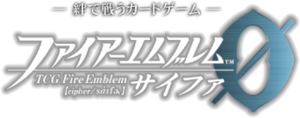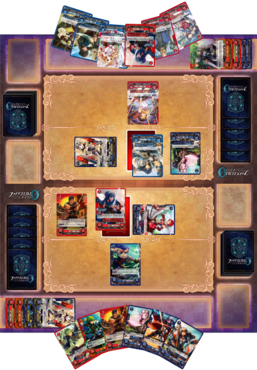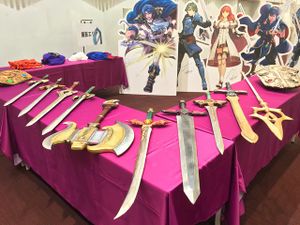Fire Emblem Cipher
- For the original TCG that ran from 2001 to 2004, see Fire Emblem Trading Card Game.
Fire Emblem Cipher[1] (Japanese: TCGファイアーエムブレム0(サイファ) TCG Fire Emblem 0 (Cipher)) is a collectible card game based on the characters and settings of the Fire Emblem series. It is the second card game based on Fire Emblem, after the original Fire Emblem Trading Card Game. Unlike its predecessor, Cipher was developed and published in-house by Intelligent Systems.[2] Cipher began publication in 2015, as part of the release of Fire Emblem Fates, and currently has twenty published series of cards with two more more upcoming. After the twenty-second series is released in October 2020, Cipher was discontinued.[3]
The game has adapted characters from every game in the main Fire Emblem series, as well as the spinoffs Tokyo Mirage Sessions ♯FE, Fire Emblem Heroes, and Fire Emblem Warriors; the spinoff Fire Emblem: Archanea Saga is the only game in the greater Fire Emblem series which was not formally-stated focus of a series. The vast majority of cards depict actual characters from the games, but since the second series, Cipher introduced eight mascot characters for the card game itself—Emma, Shade, Yuzu, Randal, Alice, Valjean, Niamh, and Poe—who regularly featured in both promotional material for the game and in cards of their own.
Unlike the original TCG, which relied primarily on a single artist to illustrate the majority of its cards, the cards of Cipher feature illustrations from a very wide variety of artists (there are 178 credited illustrators), many of whom had no prior attachment to Fire Emblem. Art contributions for Cipher were overseen by art director Daisuke Izuka, who also contributed some card illustrations himself.[4] Among these artists are several returning designers from earlier Fire Emblem games, including Sachiko Wada, Rika Suzuki and Senri Kita.
Rule set
- For more information, see the Comprehensive Rules of FE Cipher on Serenes Forest.
Cipher is a two-player game which revolves around each player building an army to defend their designated "lord" character (which can be any card with a cost of 1) from their opponent's army. When setting up the game, each player sets aside five face-down cards to act as orbs, which act as the hit points for their lord. Every time a player's lord is defeated, the player must take one of their orbs. Once a player has taken all of their orbs, then had their lord be defeated a sixth time, the game is over and that player loses.
Players deploy cards onto the battlefield as active fighters in either the Vanguard Area (front line) or the Rearguard Area (back line), but the player must also play other cards as bonds to pay the costs for deployment, class changing, and execution of certain skills which are listed on each card. During the sequence of an attack, cards are played as supports in the Support Area, where they give a bonus to the attack power of the units involved in an attack. When a unit in the Vanguard or Rearguard (except a player's lord) is defeated, it is sent to the Retreat Area, the game's discard pile.
Cards and units
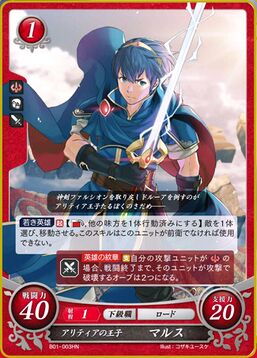
Unlike the previous Fire Emblem Trading Card Game, all cards in Cipher depict individual units. Each card is comprised of the following stats and elements:
- Name: Players are only allowed to deploy one unit with a given name onto the field, and are not allowed to deploy units if their name matches the name of a unit who is already in play.
- Title: All cards also have a title, which defines that card as a unique card compared to other cards of the same name.
- Symbol: Almost all cards are assigned one game-of-origin continent affiliation, as marked by a symbol and color: Blade of Light (Archanea/Valentia), Holy War Flag (Jugdral), Legendary Weapons (Elibe/Magvel), Medallion (Tellius), Brand (Ylisse), Hoshido, Nohr, or Crest of the Goddess (Fódlan). Certain cards, such as those for the cast of Fire Emblem Heroes, have no symbol instead.
The symbols of cards play a role in determining the ability of units to be deployed: at least one face-up bond with a given symbol must already be in play before a card of that symbol can be deployed as a unit. Symbols also play a role in certain skills. The symbol is marked in along the left edge of the card.
As of Series 10, certain Fates-themed cards have two symbols, belonging to both the Hoshido and Nohr affiliations. Deploying these cards requires that at least one face-up bond of each symbol is in play. - Affinities: All cards are marked with a number of affinities, which define their gender, the weapon type they use, and the type of unit they are. These play a role in the effects of many skills. Affinities are marked in along the left edge of the card, beneath the card's symbol.
- Class: A unit's class from the original games generally influences their affinities and usable weapons in Cipher.
- Deployment cost: The number of cards which must be played as bonds in order to deploy the unit onto your field. Found in the top-left corner of each card.
- Class change cost: The number of cards which must be played as bonds in order to deploy this unit as a class change for an already-active unit of the same name. Class change costs are only found on cards in advanced classes, which have both a deployment cost and a class change cost; the class change cost is found in the top-left corner as well, directly below the deployment cost. The card may be played as a separate unit as well, but it costs fewer bonds to use it to change the class of a card that is already in action.
- Attack power: The unit's basic strength when attacking or defending, before skills or support power come into play. Found in the bottom-left corner of the card.
- Support power: When a unit is played in the Support Area, its support power value is added to the attack power of an attacking or defending unit to increase their total attack power in that attack. Starting in Series 7, some cards have a support value of "X", which means that the card's support power varies depending on a particular aspect of the current battlefield. Found in the bottom-right corner of the card.
- Range: The range in which a unit can attack, similar to the original games. Found in the bottom-center of the card.
- A unit with 1 range can only attack enemy units in the row directly in front of them (that is, units in their Vanguard can only attack enemy units in the enemy Vanguard, and cannot attack from the Rearguard).
- A unit with 2 range can attack enemies situated two rows ahead of them (that is, if in their Vanguard they can attack enemy units in the enemy Rearguard, and if in their Rearguard they can only attack enemy units in the enemy's Vanguard).
- A unit with 1–2 range can attack under both of the above conditions.
- Skills: All units possess at least one skill which gives them a unique ability to use in gameplay. Skills tend to fall into one of six archetypes:
- [Activate] skills can be activated at will by the player, but only during their Action Phase.
- [Trigger] skills have effects which are automatically invoked when specific conditions defined by the card are met.
- [Always] skills are always active in the circumstances specified by the card, as long as the unit with the skill remains in play.
- [Bond] skills can only be used if the card is played as a bond in the Bond Area.
- [Support] skills are a separate category, which can only be used if the card is played as a support unit in the Support Area. They are divided into two further types of skills:
 Attack skills automatically activate when the player makes an attack during their Action Phase.
Attack skills automatically activate when the player makes an attack during their Action Phase. Defense skills automatically activate when defending from an opponent's attack during the opponent's Action Phase.
Defense skills automatically activate when defending from an opponent's attack during the opponent's Action Phase. Skills marked with this hybrid attack/defense icon are always in effect if the card is played as a support, regardless of turn. They are often—though not exclusively—found on cards with a support power value of "X", with the skill determining where their support power comes from.
Skills marked with this hybrid attack/defense icon are always in effect if the card is played as a support, regardless of turn. They are often—though not exclusively—found on cards with a support power value of "X", with the skill determining where their support power comes from.
- [Special] skills have effects which do not fit into the other five archetypes, often including effects which work outside how the game normally works.
Phases
In a game of Cipher, much like the main Fire Emblem games, each player takes turns to perform actions. Each player's turn is broken down into five phases:
- In the Beginning Phase, a player makes preparations for the actions they will undertake in their turn. They draw one card from their deck and add it to their hand, they untap any cards they had tapped in their last turn to allow them to perform actions again in this turn, and they invoke any skills whose requirements involve activating them at the start of the player's turn.
- In the Bond Phase, a player may play one card from their hand as a bond, placing it in the Bond Area. This may be skipped if a player chooses.
- In the Deployment Phase, a player may play cards from their hand as units in the Vanguard or Rearguard, or as class changes or level-ups for units who are already in play, as long as they have enough bonds in place to fulfill the cost requirements. This may be skipped if a player chooses.
- In the Action Phase, a player may have each of their units in play perform one of four actions: attacking, activating skills, moving from the Vanguard to the Rearguard or vice versa, or doing nothing. If a unit performs an action, the player must tap its card (rotate it 90 degrees) to mark this, preventing it from being used again in this action phase.
- To perform an attack, the player must follow several steps:
- 1. Tap the attacking unit and declare which enemy unit (within a compatible range) they wish to attack.
- 2. Compatible skills belonging to both the attacking and defending unit are activated. The attacking unit's skills take priority over the defending unit's skills (e.g. in the case of trigger skills).
- 3. Both players draw the topmost card from their deck and play it face-up as a support in the Support Area. The support power of each player's support unit is added to their active unit's attack power, and any support skills the support unit possesses are activated. Units cannot support themselves, so if the drawn support card is a unit with the same name as the player's current attacking unit (e.g. the player is attacking with Ogma and they draw another Ogma card as their support), the support fails and the drawn support card is sent to the Retreat Area.
- 4. If either player has another card with the same name as their attacking/defending unit, they have the option of playing and discarding it to influence the outcome of the battle. If this is done for an attacking unit, they perform a critical hit which doubles their attack power (including all bonuses from supports and skills), and if this is done for a defending unit, they perform an evade which nullifies an incoming attack and automatically ends the attacking sequence with no damage.
- 5. If an evade was not performed, the outcome of the attacking sequence is determined by comparing the attack power (including all bonuses from supports, skills, and critical hits) of the attacker and defender. If the attacking unit has a higher attack power, the defending unit is defeated and sent to the opponent's Retreat Area (unless they are the player's orb, in which case they remain in play and their player must take one orb). If the defending unit has a higher attack power, nothing happens and both units remain in play on the field.
- 6. Any skills possessed by either unit whose requirements involve defeating a unit or being defeated activate. The attacking unit's skills take priority.
- 7. Both players send the support card used for this attacking sequence to their Retreat Areas. The player may now move on to performing another action, or may choose to end their Action Phase.
- To perform an attack, the player must follow several steps:
- In the End Phase, the player invokes any skills whose requirements involve activating them at the end of the player's turn, and terminates any skills whose requirements involve deactivating at the end of their turn. The player's turn then ends, and the other player takes their turn and goes through these five phases from the beginning.
At the beginning of the game, the player who goes first must skip the Beginning Phase and is not allowed to initiate an attack during their Action Phase.
Series
Cipher releases a new series of cards every three months, with each series typically focused on two or three Fire Emblem games. Like most trading card games, there are two primary distribution packages: starter decks which contain a pre-determined set of 50 cards which typically focus on one Fire Emblem game or faction, and booster packs which contain 10 random cards each. Booster packs can also be bought in bulk as booster boxes, which contain 16 packs each; in addition to the 160 random cards from the enclosed packs, booster boxes also contain one promotional card previewing the next series and a set of card sleeves decorated with Fire Emblem art.
In addition to the regular starter deck and booster pack cards, some cards are distributed as promotional cards which are only available with certain purchases or by attending certain events. Some promotional cards are entirely unique, while others are reprints of pre-existing cards that feature new art. Typically there are between ten and eighteen promotional cards accompanying each series, two of which are almost always the preview cards enclosed in booster boxes.
| Launch date | Game(s) adapted | Format(s) | Total new cards | ||||
|---|---|---|---|---|---|---|---|
 第1弾 Series 1 |
June 25th, 2015 | • Shadow Dragon & the Blade of Light/Shadow Dragon • Awakening |
• Starter Decks: 暗黒戦争篇 War of Shadows Chapter 覚醒篇 Awakening Chapter (¥1,300 + tax each; 50 cards each) • Booster Pack: 英雄たちの戦刃 The Heroes' Blade of War (¥350 + tax each; 10 cards each) |
110 | |||
 第2弾 Series 2 |
September 17th, 2015 | • Fates (Birthright and Conquest) | • Starter Decks: 白夜篇 Hoshido Chapter 暗夜篇 Nohr Chapter (¥1,300 + tax each; 50 cards each) • Booster Pack: 光と闇の神焔 The Divine Flame of Light and Darkness (¥350 + tax each; 10 cards each) |
110 | |||
 第3弾 Series 3 |
December 10th, 2015 | • Path of Radiance • Fates (Revelation) |
• Starter Deck: 蒼炎の軌跡篇 Path of Radiance Chapter (¥1,300 + tax; 50 cards) • Booster Pack: 希望への雙剣 The Twin Swords to Hope (¥350 + tax each; 10 cards each) |
105 | |||
 第4弾 Series 4 |
March 17th, 2016 | • Mystery of the Emblem/New Mystery of the Emblem • Awakening • Tokyo Mirage Sessions ♯FE |
• Starter Deck: 幻影篇 Illusory Chapter (¥1,300 + tax; 50 cards) • Booster Pack: 煌めき幻奏 Shining Illusong (¥350 + tax each; 10 cards each) |
105 | |||
 第5弾 Series 5 |
June 23rd, 2016 | • The Binding Blade • Radiant Dawn |
• Starter Deck: 封印動乱篇 Binding Disturbance Chapter (¥1,300 + tax; 50 cards) • Booster Pack: 相剋を越えて Beyond the Rivalry (¥350 + tax each; 10 cards each) |
105 | |||
 第6弾 Series 6 |
September 29th, 2016 | • Genealogy of the Holy War (1st generation) • Fates (Conquest and Revelation) |
• Starter Deck: 聖戦の系譜篇 Genealogy of the Holy War Chapter (¥1,300 + tax; 50 cards) • Booster Pack: 閃駆ノ騎影 Storm of the Knights' Shadows (¥350 + tax each; 10 cards each) |
105 | |||
 第7弾 Series 7 |
December 8th, 2016 | • The Blazing Blade • Fates (Birthright and Revelation) |
• Booster Pack: 士道を征く Conquest of Honor (¥350 + tax each; 10 cards each) |
100 | |||
 第8弾 Series 8 |
March 16th, 2017 | • Awakening • Genealogy of the Holy War (2nd generation) |
• Booster Pack: 生と死-運命の先へ Life and Death: Beyond Fate (¥350 + tax each; 10 cards each) |
100 | |||
 第9弾 Series 9 |
June 22nd, 2017 | • Gaiden/Echoes: Shadows of Valentia • The Binding Blade/Hasha no Tsurugi • Path of Radiance/Radiant Dawn |
• Starter Deck: 神々の大地篇 Land of the Gods Chapter (¥1,300 + tax; 50 cards) • Booster Pack: 響地轟轟 Thunderous Earth (¥350 + tax each; 10 cards each) |
106 | |||
 第10弾 Series 10 |
September 21st, 2017 | • Thracia 776 • Fates (Birthright, Conquest, and Heirs of Fate) • Heroes[5] |
• Booster Pack: クロスローズ Crossroads (¥350 + tax each; 10 cards each) |
100 | |||
 第11弾 Series 11 |
December 7th, 2017 | • Gaiden/Echoes: Shadows of Valentia • The Sacred Stones • Warriors[6] |
• Booster Pack: Glorious Twinstrike[7] (¥350 + tax each; 10 cards each) |
100 | |||
 第12弾 Series 12 |
March 22nd, 2018 | • Genealogy of the Holy War • Path of Radiance/Radiant Dawn • Awakening[8] |
• Booster Pack: 荒れ狂う破濤 Raging Deluge (¥350 + tax each; 10 cards each) |
100 | |||
 第13弾 Series 13 |
June 28th, 2018 | • The Blazing Blade • Shadow Dragon & the Blade of Light/Shadow Dragon • Heroes[9] |
• Starter Deck: 烈火の剣篇 The Blazing Blade Chapter (¥1,480 + tax; 50 cards) • Booster Pack: 炎と鋼と想と哀と Flame, Steel, Thought, and Grief (¥350 + tax each; 10 cards each) |
105 | |||
 第14弾 Series 14 |
September 27, 2018 | • Awakening • Fates (Birthright) • Path of Radiance/Radiant Dawn • Tokyo Mirage Sessions ♯FE |
• Booster Pack: 瞳の見つめる未来 Eyes Gazing at the Future (¥350 + tax each; 10 cards each) |
100 | |||
 第15弾 Series 15 |
December 13, 2018 | • New Mystery of the Emblem • Fates (Conquest) • Genealogy of the Holy War/Thracia 776 • Tokyo Mirage Sessions ♯FE |
• Booster Pack: 輝く世界 Shining World (¥350 + tax each; 10 cards each) |
100 | |||
 第16弾 Series 16 |
March 22, 2019 | • The Binding Blade • Echoes: Shadows of Valentia • Radiant Dawn • Heroes |
• Booster Pack: 勇気よ燃ゆる魂よ O Courage, O Burning Soul (¥350 + tax each; 10 cards each) |
100 | |||
 第17弾 Series 17 |
June 27, 2019 | Entire greater Fire Emblem series to that point except Fire Emblem: Archanea Saga and Warriors |
• Starter Deck: 絆の戦士たち篇 Warriors of Bonds Chapter (¥1,480 + tax; 50 cards) • Booster Pack: 英雄総進軍 All-Out March of the Heroes (¥350 + tax each; 10 cards each) |
122 | |||
 第18弾 Series 18 |
September 26, 2019 | • Three Houses • Awakening • The Sacred Stones • Tokyo Mirage Sessions ♯FE |
• Starter Deck: 風花雪月篇 Three Houses Chapter (¥1,480 + tax; 50 cards) • Booster Pack: 雄飛のオラトリオ Oratorio of Departure (¥350 + tax each; 10 cards each) |
109 | |||
 第19弾 Series 19 |
December 12, 2019 | • Three Houses • Genealogy of the Holy War |
• Booster Pack: 覇天の聖焔 Holy Flames of Sublime Heaven (¥350 + tax each; 10 cards each) |
103 | |||
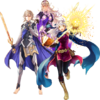 第20弾 Series 20 |
March 19, 2020 | • Fates (all three campaigns) • Path of Radiance • Radiant Dawn |
• Booster Pack: その手が導く夜明け The Dawn's Guiding Hand (¥350 + tax each; 10 cards each) |
103 | |||
 第21弾 Series 21 |
June 25, 2020 | • Three Houses • The Binding Blade • The Blazing Blade • Heroes |
• Booster Pack: 劫火の嵐 Tempest of Apocalyptic Flame (¥350 + tax each; 10 cards each) |
103 | |||
 第22弾 Series 22 |
October 1, 2020 | Entire greater Fire Emblem series to that point except Fire Emblem: Archanea Saga, plus one tie-in manga
|
• Booster Pack: 英雄たちの凱歌 Victory Song of Heroes (¥350 + tax each; 10 cards each) |
115 | |||
Card rarities
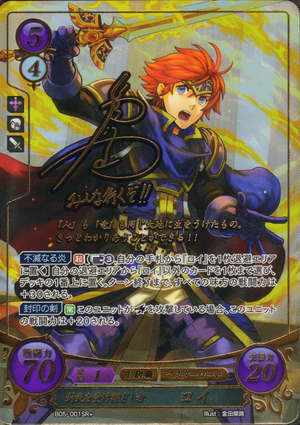
Cards are grouped by rarities, which determine how likely it is to find a given card in a booster pack. Rarity is denoted in the card's number as a 1/2 letter suffix.
- N (Normal) is the most common rarity. Normal cards typically have a deployment cost of 1 and depict units in base classes. Each series typically features 42 N cards.
- HN (High Normal) cards are reasonably common, but not as common as N cards. HN cards are typically split between cards which depict less important/popular units in advanced classes, and additional base-class cards for more popular characters. Each series typically features 30 HN cards.
- R (Rare) cards are, as the name suggests, rare. They generally feature mildly popular and important units in advanced classes, with better skills than HN cards. R cards are printed in holographic foil. Each series typically features 16 R cards.
- SR (Super Rare) is the highest rarity. It is usually reserved for the most important and/or popular characters in a Fire Emblem game in advanced classes, with the highest deployment costs and the most powerful and unique skill effects. Like R cards, they are printed in holographic foil. Each series typically features 12 SR cards.
Each booster pack contains six N cards, three HN cards, and 1 card that is either an R, an SR, or one of their respective + variants.
Some R and SR cards are also given alternate, even more rare R+ and SR+ prints, which usually feature either different art or the signature of the character's Japanese voice actor or, less frequently, the card's artist. Each series features 6 SR+ cards and 8 R+ cards, and like the regular R and SR cards, they are also printed in holographic foil. On average, there is only one card of any + rarity in each booster box.
Starting from Series 5, each series also contains one card of +X rarity (usually R+X, although Series 9 had a N+X card instead), which are usually special preview prints of cards due for release six months/two series later, usually from the one of the same symbol affiliations as is featured in the current set; for example, the first R+X card, Eliwood, was released in Series 5 (a set that prominently featured Elibe) before its regular R counterpart was released in Series 7. +X cards are treated as a secret by Intelligent Systems, in that they are never revealed before the series is released, and they are not even added to the card list on the official website until several weeks after the series' release.
In addition to these rarities, all cards contained in starter decks are designated as ST rarity, since every card in a starter deck is predetermined. Almost all promotional cards are designated PR (certain reprints of earlier promotional cards are designated PRr instead).
Promotion
Live streams promoting Cipher were periodically held every one or two months on the Japanese video site Niconico, previewing cards and artwork for upcoming Cipher sets as well as both announcing new events and covering the outcomes of recent ones. The live streams were hosted by Ryota Kawade, the producer of Cipher, and by Young, another Intelligent Systems employee. They were accompanied by guest artists and voice actors; frequently recurring guests included Eri Suzuki, Emma's voice actress; Michihiko Hagi, Ike's voice actor; Kenichi Hatori, a prop maker; and Yusuke Kozaki. Occasionally, the live streams were also used to announce upcoming products and features for other Fire Emblem products, such as Fire Emblem Heroes and Fire Emblem Echoes: Shadows of Valentia.
The Cipher Frontier! was a roughly-monthly news column on the official website, hosted by the mascot characters Emma, Shade, Yuzu, Randal, Alice, Valjean, Niamh, and Poe. The columns provided similar news to the live streams, even summarizing their news in issues released after a live stream has aired, and frequently included the first looks at the packages for upcoming card series and for pieces of artwork from them.
On every weekday, the Cipher Twitter account showcased one or two cards, including introducing new cards for upcoming series in the month before it was released. Once a set was released, it continued to showcase cards from that set until it moved onto the next upcoming series. The Twitter account also announces upcoming events, live streams, and The Cipher Frontier! columns.
For the purposes of promoting Cipher, Intelligent Systems had commissioned prop-maker Kenichi Hatori to produce replicas of prominent Fire Emblem weapons, which are frequently seen at events and on the live streams. The weapons he had produced replicas of include the Mystery and Awakening versions of Falchion and the Fire Emblem, the Binding Blade, Durandal, Armads, Tyrfing, Ragnell, and Yato.
Emma, Shade, Yuzu, and Randal star in a crossover with Echoes: Shadows of Valentia in the "Cipher Companions" downloadable content pack, which adds them to the game as playable units; the subsequent mascots are not featured, as they were introduced after the release of this DLC. Despite the card game remaining exclusive to Japan, this DLC was released in all regions.[1]
Trivia
- The Cipher logo contains a transcription of the word "cipher" in the International Phonetic Alphabet. However, it contains an error; in IPA, stress marks are supposed to be placed at the start of a syllable (/ˈsaɪfɚ/[key]), but the logo writes it with the stress mark over the ⟨a⟩ (/sa̍ɪfɚ/). This instead makes it look like the mark for syllabic consonants.
Etymology and other languages
| Names, etymology, and in other regions | ||
|---|---|---|
| Language | Name | Definition, etymology, and notes |
| English |
|
|
| Japanese |
TCGファイアーエムブレム0(サイファ) |
TCG Fire Emblem 0 (Cipher); "Cipher" here is used as the pronunciation of the 0. |
| French |
|
|
Gallery
References
- ↑ 1.0 1.1 Expand your adventure with new downloadable content for Fire Emblem Echoes: Shadows of Valentia from 19th May, Nintendo UK, Published: May 3, 2017, Retrieved: May 5, 2017
- ↑ Sato, Fire Emblem Also Gets A New Card Game And Manga In Japan, Siliconera, Published: January 15, 2015, Retrieved: April 5, 2015
- ↑ @FEcipher, [1], Twitter, Published: April 1, 2020, Retrieved: April 2, 2020
- ↑ pasu, [English Translation] Emma and Shade from the frontlines of Cipher!, Serenes Forest Forums, Published: August 10, 2015, Retrieved: August 10, 2015
- ↑ Kirie, Cipher Series 8 Pre-Release Livestream!, Serenes Forest, Published: March 13, 2017, Retrieved: March 21, 2017
- ↑ Kirie, Cipher Winter Livestream: S8 Cards, New Artwork, & Upcoming Series News!, Serenes Forest, Published: February 12, 2017, Retrieved: March 21, 2017
- ↑ Fire Emblem Cipher; trans. bookofholsety, The Cipher Frontier! Issue 31: "I am Alice! And I, Val. Debut of the New Members!", Tumblr, Published: August 25, 2017, Retrieved: August 26, 2017
- ↑ Kirie, Cipher Summer Livestream 2017: New S10 Cards, The Sacred Stones Artwork, & S12 Announcement!, Serenes Forest, Published: August 20, 2017, Retrieved: August 26, 2017
- ↑ Kirie, Cipher Autumn 2018 Livesteam: New S11 Cards, S12 Artwork, & S13 Announcement!, Serenes Forest, Published: November 8, 2017, Retrieved: February 16, 2018
External links
- Fire Emblem Cipher official Japanese website
| Fire Emblem Cipher | ||||||||
|---|---|---|---|---|---|---|---|---|
|
| Merchandise | |||||||||||||||||||||||||||
|---|---|---|---|---|---|---|---|---|---|---|---|---|---|---|---|---|---|---|---|---|---|---|---|---|---|---|---|
| |||||||||||||||||||||||||||
